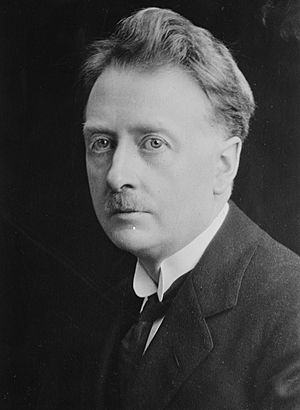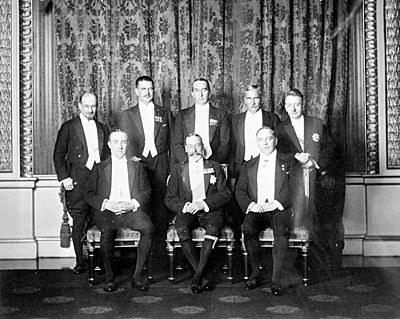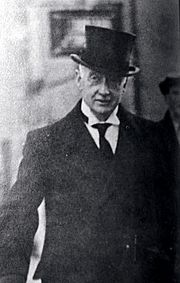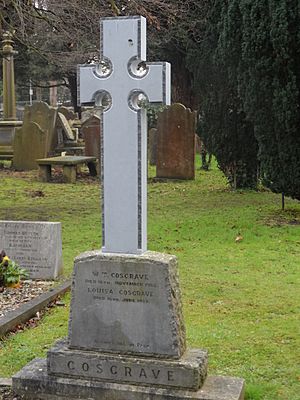W. T. Cosgrave facts for kids
Quick facts for kids
W. T. Cosgrave
|
|
|---|---|
 |
|
| 1st President of the Executive Council | |
| In office 6 December 1922 – 9 March 1932 |
|
| Governor-General |
|
| Vice President | Kevin O'Higgins Ernest Blythe |
| Preceded by | Michael Collins (as Chairman of the Provisional Government) |
| Succeeded by | Éamon de Valera |
| Leader of the Opposition | |
| In office 9 March 1932 – 11 January 1944 |
|
| President | Douglas Hyde |
| Taoiseach | Éamon de Valera |
| Preceded by | Éamon de Valera |
| Succeeded by | Richard Mulcahy |
| Leader of Fine Gael | |
| In office 20 June 1934 – 30 May 1944 |
|
| Preceded by | Eoin O'Duffy |
| Succeeded by | Richard Mulcahy |
| Leader of Cumann na nGaedheal | |
| In office 20 April 1923 – 15 May 1933 |
|
| Preceded by | New office |
| Succeeded by | Office abolished |
| Chairman of the Provisional Government | |
| In office 22 August 1922 – 6 December 1922 |
|
| Preceded by | Michael Collins |
| Succeeded by | Office abolished |
| President of Dáil Éireann | |
| In office 9 September 1922 – 6 December 1922 |
|
| Preceded by | Arthur Griffith |
| Succeeded by | Office abolished |
| Minister for Finance | |
| In office 17 July 1922 – 21 September 1923 |
|
| President | Michael Collins |
| Preceded by | Michael Collins |
| Succeeded by | Ernest Blythe |
| Minister for Local Government | |
| In office 2 April 1919 – 22 August 1922 |
|
| President | Michael Collins |
| Preceded by | New office |
| Succeeded by | Ernest Blythe |
| Teachta Dála | |
| In office September 1927 – May 1944 |
|
| Constituency | Cork Borough |
| In office May 1921 – September 1927 |
|
| Constituency | Carlow–Kilkenny |
| Member of Parliament | |
| In office 14 December 1918 – 26 October 1922 |
|
| Preceded by | Michael Meagher |
| Succeeded by | Office abolished |
| Constituency | North Kilkenny |
| Personal details | |
| Born |
William Thomas Cosgrave
5 June 1880 The Liberties, Dublin, Dublin, Ireland |
| Died | 16 November 1965 (aged 85) The Liberties, Dublin, Ireland |
| Resting place | Goldenbridge Cemetery, Inchicore, Dublin, Ireland |
| Political party | Fine Gael |
| Other political affiliations |
|
| Spouses | Louisa Flanagan (m. 1919; d. 1959) |
| Relations |
|
| Children | 2, including Liam |
| Education | St. Joseph's School, Marino |
| Military service | |
| Allegiance | Irish Republic |
| Years of service | 1913–16 |
| Rank | Captain |
| Battles/wars | Easter Rising |
William Thomas Cosgrave (born 5 June 1880 – died 16 November 1965) was an important Irish politician. He was the first head of government for the Irish Free State. This was a new country that became independent in 1922.
Cosgrave led the government as the President of the Executive Council from 1922 to 1932. He also helped create and lead the political party Cumann na nGaedheal. Later, he led Fine Gael, another major Irish party. His son, Liam, also became a leader of Ireland much later.
Contents
Early Life and Family
William Thomas Cosgrave was born in Dublin in 1880. His father was a grocer. William went to school at the Christian Brothers School in Marino. After school, he worked in his father's business.
Cosgrave became interested in politics when he joined the first meeting of Sinn Féin in 1905. He was a Sinn Féin councillor in Dublin Corporation from 1909 to 1922. In 1913, he joined the Irish Volunteers. He did not join the Irish Republican Brotherhood because he did not like secret groups.
Role in the Easter Rising
Cosgrave played an active part in the Easter Rising of 1916. He was a Captain in the South Dublin Union. After the rebellion, he was sentenced to death. However, his sentence was changed to life in prison. He was sent to Frongoch internment camp in Wales.
While in prison, he won a seat in the Kilkenny City election in 1917. After he was released in 1919, he took his seat in the First Dáil. This was the first Irish parliament. On 24 June 1919, he married Louisa Flanagan in Dublin.
Political Journey
Minister for Local Government
Even though Cosgrave was very experienced, he was not part of the main leadership of Sinn Féin. However, in 1919, Éamon de Valera made him the Secretary of Local Government. Cosgrave was chosen because he was friends with de Valera. He also had a lot of experience in local government.
His main job was to help Irish people stop cooperating with the British government. He also worked to set up an Irish system of government. After the 1920 local elections, most local councils supported the new Irish government. They then cut ties with the British government.
Supporting the Anglo-Irish Treaty
Cosgrave supported the Anglo-Irish Treaty, signed in December 1921. This treaty created the Irish Free State. It gave Ireland more independence but kept some links to Britain. Cosgrave agreed with Michael Collins and Arthur Griffith that the treaty was the best option.
The Dáil voted to accept the treaty, but de Valera voted against it. De Valera then resigned as president. Griffith became the new president. Collins formed a Provisional Government, and Cosgrave was part of it. He also became Minister for Finance in July 1922.
Leading the Provisional Government
After the treaty was accepted, Ireland moved towards a civil war. Sinn Féin split into two groups: those who supported the treaty and those who did not. In August 1922, both Griffith and Collins died suddenly. Griffith died of natural causes, and Collins was killed in an ambush.
With these leaders gone, the pro-Treaty side needed a new leader. They chose Cosgrave because of his experience as a politician. On 30 August, he became the Chairman of the Provisional Government. On 9 September, he also became the President of Dáil Éireann. He held both roles until the Irish Free State officially began on 6 December 1922.
President of the Executive Council (1922–1932)
On 6 December 1922, the Dáil elected Cosgrave as the first President of the Executive Council. He was 42 years old, the oldest in his cabinet. He did not seek the leadership, but he used it well. His main goal was to keep the new country together. He wanted to show that the Irish could govern themselves.
Historians say he was a good leader for the new Irish state. He made good decisions for the country.
Domestic Policies
During the Civil War, Cosgrave was firm in defending the new state. In October 1922, he passed a Public Safety Bill. This law allowed for the execution of anyone fighting against the state. He believed this was the only way to restore order.
He said that if harsh actions were not taken, the war could go on forever. His army executed 77 rebels by May 1923. This was more than the British had executed during the War of Independence. Anti-Treaty fighters attacked pro-Treaty politicians and their homes. Cosgrave's family home was burned down, and an uncle was killed.
Cosgrave stated, "I am not going to hesitate if the country is to live."
In April 1923, pro-Treaty Sinn Féin members formed a new party called Cumann na nGaedheal. Cosgrave became its leader. The Civil War ended the next month.
One of his first actions as leader was to pass a Bill for the Constitution of the Irish Free State. This was done by October 1922. It helped formally establish the Free State in December.
The new government faced challenges. They tried to reduce the size of the National Army. It had grown very large during the Civil War. Some army officers were unhappy about the cuts. They felt the government was not doing enough to create a full republic.
In March 1924, some army officers demanded an end to the cuts. Minister for Justice Kevin O'Higgins helped solve this "Army Mutiny." The crisis was resolved, but it caused divisions within the government.
The Boundary Commission
In 1924, Britain and Ireland agreed to a Boundary Commission. This group was meant to redraw the border between the Irish Free State and Northern Ireland. The Free State hoped to gain land where many Catholics and republicans lived.
However, a newspaper reported that the border would not change much. It even said the Free State might lose some land. The Free State's representative, Eoin MacNeill, resigned. Cosgrave quickly went to London. He met with the British and Northern Irish leaders. They agreed to keep the border as it was. In return, the Free State did not have to pay its share of the old Imperial debt. Cosgrave said he wanted "a huge nought" for the debt, and he got it.
In June 1927, a general election was held. De Valera's new party, Fianna Fáil, won many seats. In July, Kevin O'Higgins, a minister, was killed by the IRA. The government then passed a law to make Fianna Fáil take their seats in the Dáil. De Valera and his party entered the Dáil in August. This changed the political situation, as Cosgrave now faced strong opposition.
Foreign Policies
Cosgrave and his government accepted that the Irish Free State was a dominion. But they wanted to make sure Britain respected Ireland's new independence. They took steps to strengthen Ireland's position in the world. In 1923, the Irish Free State joined the League of Nations.
Ireland was also the first British Commonwealth country to have its own representative in Washington, D.C.. They also exchanged diplomats with other European countries. In 1926, Cosgrave received an honour from Pope Pius XI.
The Anglo-Irish Treaty gave Ireland more independence than other dominions. The Oath of Allegiance in Ireland was less focused on the king. The king's representative in Ireland was Irish, unlike in other dominions. Power came from the Irish people, not the king. The League of Nations also recognized the Treaty as an international agreement in 1924.

In 1931, the Statute of Westminster gave the Free State full independence in law. This made the Free State an internationally recognized independent Irish state.
Economic Policies
During Cosgrave's ten years in power, his government followed a careful economic plan. They kept taxes low and balanced the budget. The Irish currency stayed linked to the British currency. They supported free trade but added some tariffs (taxes on imported goods).
The government focused on farming. They introduced better quality control and helped farmers buy their land. The Irish Sugar Company and the Agricultural Credit Corporation were also set up. However, the economic problems of the 1930s made things difficult. Industry was not given as much attention as farming. But the Electricity Supply Board was created. It built the first national electricity grid in Europe, providing jobs and power.
The 1932 General Election
Cosgrave called a general election for February 1932. There was growing unrest in the country. He also wanted a fresh mandate for an important Commonwealth meeting. Another reason was the Eucharistic Congress in June. This was a big national and international event.
Cosgrave, a religious man, wanted the Congress to go smoothly. His party, Cumann na nGaedheal, campaigned on their record of honest government. They also tried to portray Fianna Fáil as communists. But Fianna Fáil offered new ideas and social reforms. Cosgrave and his party lost the election. A minority Fianna Fáil government, led by Éamon de Valera, came to power.
Cosgrave in Opposition
After losing the 1932 election, Cosgrave became the Leader of the Opposition. Fianna Fáil then governed for 16 years. In 1933, Cumann na nGaedheal joined with two other groups to form a new party called Fine Gael. Cosgrave became the deputy leader.
Since the party leader, Eoin O'Duffy, was not in the Dáil, Cosgrave remained the Leader of the Opposition. He became the full party leader the next year. Under his leadership, Fine Gael lost elections in 1937, 1938, and 1943. Cosgrave retired as party leader in 1944. Richard Mulcahy took over.
His Impact on Ireland
Cosgrave was a calm and effective leader, not a flashy one. He led Ireland during a very difficult time. He helped create the laws and institutions needed for a stable, independent Irish state. His governments played a key role in changing the British Empire into the British Commonwealth. They changed how the Crown and the British government worked within the Commonwealth.
Cosgrave's leadership helped keep the Free State democratic. Many other governments after the First World War became dictatorships. But Cosgrave handed over power peacefully to his rival, Éamon de Valera, after losing the 1932 election. This stopped any talk of the Irish Army trying to take power.
Even his old rival, Éamon de Valera, praised Cosgrave. After de Valera took power in 1932, he read the government files. He told his son, "They did a magnificent job."
Death and Legacy
William T. Cosgrave died on 16 November 1965, at 85 years old. The government gave him a state funeral. Many important people attended, including Éamon de Valera, who was then President of Ireland. Cosgrave is buried in Goldenbridge Cemetery in Inchicore, Dublin.
Richard Mulcahy, another politician, praised Cosgrave. He said Cosgrave had a "steel-like spirit of rectitude, courage and humble self-sacrifice."
Cosgrave's son, Liam, also became a TD (a member of the Irish parliament). He later led Fine Gael and served as Taoiseach (Prime Minister) from 1973 to 1977. Cosgrave's grandson, Liam, also became a TD and Senator.
In 2014 and 2016, Cosgrave's grave was damaged by vandals.
Images for kids
-
Cosgrave (holding furled umbrella) visiting the sugar beet processing factory at Strawhall, County Carlow, October 1926
See also
 In Spanish: William Thomas Cosgrave para niños
In Spanish: William Thomas Cosgrave para niños
- Families in the Oireachtas
- List of people on stamps of Ireland




